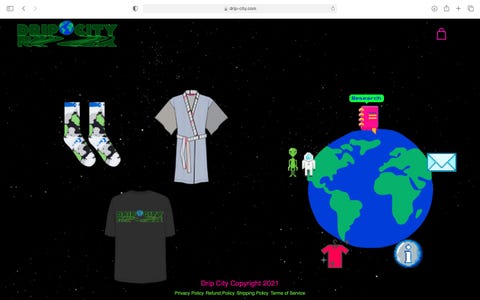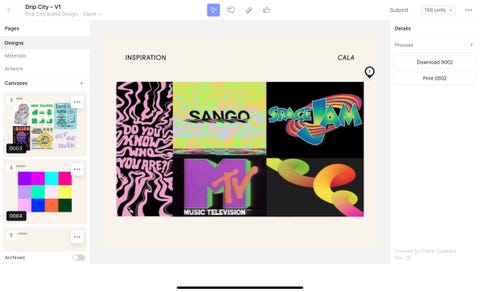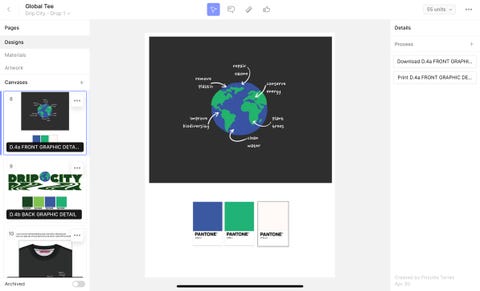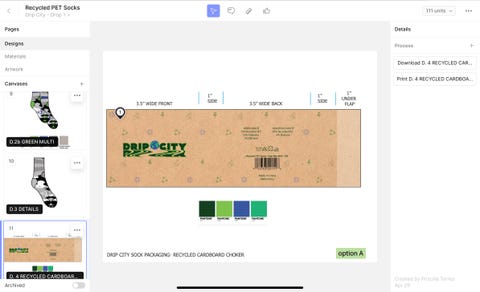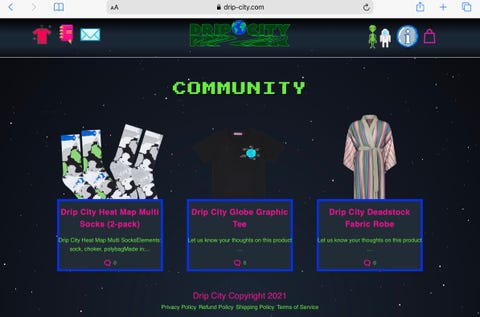Disclaimer: Even though I’ve spent the last decade writing about fashion, technology, and sustainability, it occurred to me earlier this year that I have zero firsthand experience designing clothes. Or making sustainable design decisions. Or utilizing technology for those purposes. To remedy this, I embarked on a journey to launch an experimental fashion brand utilizing CALA, the world’s first operating system for fashion. (Yes, you read that correctly.)
For background, CALA works with a number of brands including FabFitFun and Y,IWO (aka Yeah, I Work Out) and is made up of a team of experts that hail from the likes of Yeezy, Kith, Balenciaga, Rick Owens, and Fendi. The company has completely reengineered the experience of launching or scaling a brand through a digital lens, and helps with everything from brand building to product design, assortment planning, website development, e-commerce management, merchandising, pricing, marketing, fulfillment, you name it. While some brands come to them for just one or a few solutions, I needed all the help I could get, so I engaged with them in a soup-to-nuts capacity.
Throughout the process, I learned a whole lot from the many challenges that come with launching a fashion brand and trying to navigate how to design a clothing line responsibly in 2021 and beyond. To give you some insight into how exactly it can be done, I chronicled the full journey here.
What’s in a Name?
Turns out—everything. After the team at CALA gave me my first walk through of how to use their platform, we dove into a brainstorm session to think through important branding elements, starting with the name (naturally). Although I had plenty in mind, the CALA team helped me understand that, when it comes to a name, it’s not just about what sounds best, it’s also about what is available to trademark, what can be easily searched and found, and what best speaks to the brand’s ethos. Turns out, trademarking a name can cost anything from a few hundred dollars (if you do it on your own) to a couple thousand (if you engage with a lawyer). Fortunately, I had randomly trademarked the name “Drip City” some time ago, so to save on legal expenses and time, I just went with that. (To be fair, I realize I already cheated on the first task.)
The Beast That Is Branding
From typography to color palette and logo, branding is both super important and super complex. I definitely tested the CALA team’s patience more at this point than at any other step during the design process. We started with a mood board full of ‘90s nostalgia and vintage Earth Day graphics, which we easily assembled on the CALA platform. Though I kept erring toward a serious tone due to the sustainability of it all, the team continued to remind me that this brand should be a reflection of my aesthetic, which is just as much goofball as it is academic. As a result, the movie Bio-Dome became a real point of inspiration—surfacing topics of sustainability wrapped in humor. Sincere thanks to the stars of the film: Pauly Shore, Stephen Baldwin, Joey Lauren Adams, Kylie Minogue, and Rose McGowan.
After going through many iterations of logos, permanent and seasonal colors, fonts, and even social media badges, I ended up with a solid brand book that probably would have cost close to six figures had I worked with a traditional branding agency. No detail was left unturned including best color pairings and ways to position—and not position—the logo.
Put the “Design” in Designer
With branding out of the way, it was time to move on to the product itself. To do so, I worked closely with CALA’s Senior Operations Manager, John Renaud, to choose three fairly ubiquitous items including a sock, a T-shirt, and a robe. For the sock, Renaud recommended that I use recycled polyethylene terephthalate (rPET), a type of polyester produced from plastic post consumer waste, such as disposable water bottles. (Companies like Everlane and Uniqlo have been using this material for quite some time.) The end result was a gray sock made out of 97 percent rPET and 3 percent elastane, along with a blue/green version made out of 75 percent recycled PET, 22 percent virgin polyester, and 3 percent elastane. Each pair is equivalent to approximately six plastic water bottles! My goal with the robe was to work with a woman-owned and operated factory; thankfully, we found one in India that uses deadstock fabrics, so Renaud and I mix and matched them, ultimately having to change the shape slightly to accommodate how much the factory had in stock of our chosen colorway. When it came to the T-shirt, CALA paired me with a graphic designer who took the inspiration I uploaded to their platform and turned it into what it is today: a blank template made of 65 percent recycled cotton (cotton yarn that has been taken from old garments and then shredded, cleaned, and combed to make it like new) and 35 percent rPET.
Wrap It Up
On the packaging side of things, I learned a ton. First, warehouses often require each item to be individually packaged for both quality control and sanitary reasons. This means that doing away with packaging for each individual item is difficult. Designers like myself who don’t have the means to create their own sustainably made packaging that then gets returned and reused have to think about how to achieve sustainability in packaging in a different way. For both the socks and the robes, we asked the factories to use what was nearby to avoid having to ship polybags across the globe. For the T-shirts, the factory sourced recycled plastic polybags made domestically in the U.S. and had them sent to their facilities. The choker on the sock is made out of recycled cardboard, and the products are packaged in 100 percent recycled corrugated boxes in the distribution center (a last-minute surprise expense, but well worth it).
Lost in the Web
While I love website design, development is another animal altogether. CALA came through with an incredible developer, who made all my dreams come true with floating products, random menu icons, space for my research, thoughts to live in blog form, a community forum for anyone to share ideas, a Star Wars-inspired “About” page, and even a food label-inspired product description box. After jumping over a few other unexpected hurdles—pricing, marketing, warehousing, and setting up a bank account—we were finally ready to launch.
I came to the conclusion that fashion design is one part skill (that can be learned) and one part inherent talent—and it is critical to have a team who can fill in any educational gaps. In particular, being sustainable and responsible is even more complex and convoluted than I initially thought. Sustainable materials aren’t always better, what is advertised is not always what you get, and it can be really, really (really) expensive. The pandemic added additional hurdles, including travel restrictions, factory closures, and shipping delays. Being a responsible designer today means relentlessly researching, asking far too many questions, opening up two-way conversations for the community to teach you, and sometimes having to settle for the best you can afford to actually do.
Let me be the first to admit that, at times, it was difficult to move forward because I was so overwhelmed with research, trying to figure out what was better for the planet, and thinking through costs before even being able to focus on what looked good. I’m happy where we landed. It takes an army!
This content is created and maintained by a third party, and imported onto this page to help users provide their email addresses. You may be able to find more information about this and similar content at piano.io

